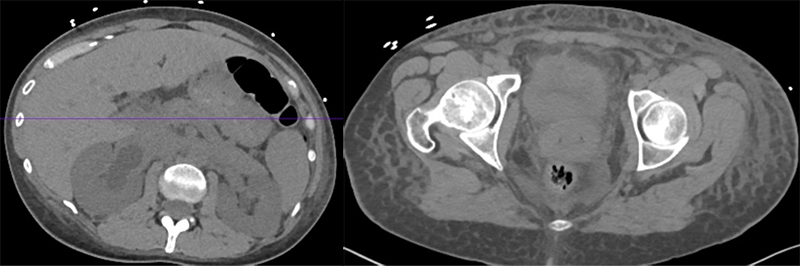Cervical cancer, the second-leading cause of death among women ages 20-39, can be a rare form of acute renal failure.
Cervical cancer is the second leading cause of cancer-related death in women aged 20-39 years.1,2 Though cervical cancer is largely preventable with adequate screening and administration of the HPV vaccine, 13,170 women will be diagnosed with cervical cancer this year and 4,250 will die. Women in areas of lower socio-economic status are disproportionally affected by cervical cancer.5 In later stages of cancer an enlarged tumor burden and metastasis may cause urinary obstruction. This case describes a previously healthy woman who presented to the ED with symptoms of abdominal pain and vaginal bleeding who was found to have a urinary obstruction from a metastatic mass.
Case
A 37-year-old female patient presented to the ED with leg swelling and abdominal pain for the past 6 weeks that was causing difficulty with ambulation. She denied weight loss, chest pain, shortness of breath, nausea or vomiting, urinary symptoms, or paresthesia. Past history was significant for previous intravenous drug use. Physical examination revealed a female with normal vital signs. Her cardiopulmonary exam was normal. The vaginal exam showed a friable, bloody, painful cervix with loss of normal anatomy. Examination of her extremities showed pitting edema of the left lower extremity up to the thigh with normal pulses and tenderness to palpation. Testing showed a urinalysis positive for nitrites and leukocyte esterase, negative for bacteria, with too numerous to count red blood cells and white blood cells. A doppler study showed an acute DVT of the left lower extremity. A CT of her abdomen showed right sided mild hydronephrosis secondary to a suspected mass. She opted for outpatient follow up and was sent home with antibiotics for her urinary tract infection and anticoagulation for her DVT.
She returned 2 weeks later with increasing shortness of breath, decreased urination, and excruciating back pain. She had not filled her prescriptions, but did follow up with the tertiary care OB oncologist, who confirmed a diagnosis of cervical cancer. Physical examination revealed tachycardia and increased lower left extremity pitting edema with pain to palpation. Her creatinine was 8.8 mg/dL with a GFR of 6. A VQ scan was performed and read as low probability for pulmonary embolism. A CT of her abdomen showed anasarca, high grade bilateral hydronephrosis and an enlarged bladder mass. She was admitted for further treatment workup.

Discussion
Cervical cancer is most frequently diagnosed between the ages of 35 and 44, with only 15% diagnosed in women over the age of 65.5 The American College of Gynecology recommends screening beginning at age 21 with a Pap smear every 3 years.3
Survival is 66% at 5 years, but is impacted by race, ethnicity, and age. The 5-year survival rate for women with invasive cervical cancer is 92%; once the cancer has metastasized to surrounding tissues, or organs and lymph nodes, the 5-year survival rate drops to 56% and with distal metastasis, the 5-year survival is only 17%.
The most frequent strains of HPV associated with cervical cancer are strains 16 and 18. Women with lowered immune function, such as patients with HIV/AIDS or chronic steroid use, are noted to have less ability to fight off early cancer cells. Women who have herpes, smoke, lower socioeconomic status, or poor access to screening have an increased risk of invasive disease. Oral contraceptives have also been shown to increase the risk of cervical cancer.4
If cervical cancer invades into the urinary system, obstruction to the renal collecting system can occur with subsequent development of hydronephrosis. Continued lymph node encroachment, inflammation, and scarring of the pelvic rim often worsens hydronephrosis. Treatment of post-obstructive renal failure in cervical cancer patients typically includes stent placement, or urinary diversion procedure, such as percutaneous nephrostomy tubes, which aids in the recovery of renal function in 61.7% of patients.1
Case Conclusion
Bilateral nephrostomy tubes were placed to relieve the obstruction. PET scan found metastatic lesions in the sacral and hip bones, as well as to the lungs. The patient was discharged on hospice with home health.
Take-Home Points
- Cervical cancer can be a rare form of acute renal failure.
- In young and otherwise healthy patients, malignancy can be a cause of acute DVT.
- Late stage cervical cancer can metastasize to distant sites such as the bones, lungs and other pelvic organs.
References
- Souza, et al. Cervical Cancer: Renal Complications and Survival after Percutaneous Nephrostomy. Revista Da Associação Médica Brasileira, Associação Médica Brasileira, http://www.scielo.br/scielo.php?script=sci_arttext&pid=S0104-42302016000300255.
- Siegel, Rebecca L., et al. Cancer Statistics, 2019. Wiley Online Library, American Cancer Society, 8 Jan. 2019, https://onlinelibrary.wiley.com/doi/pdf/10.3322/caac.21551.
- Women's Health Care Physicians. ACOG. https://www.acog.org/Patients/FAQs/Cervical-Cancer-Screening-Infographic.
- Kashyap, Nainakshi, et al. Risk Factors of Cervical Cancer: A Case-Control Study. Asia-Pacific Journal of Oncology Nursing, Wolters Kluwer - Medknow, 2019, https://www.ncbi.nlm.nih.gov/pmc/articles/PMC6518992/.
- Key Statistics for Cervical Cancer. American Cancer Society, Jan. 8 2019, https://www.cancer.org/cancer/cervical-cancer/about/key-statistics.html.



